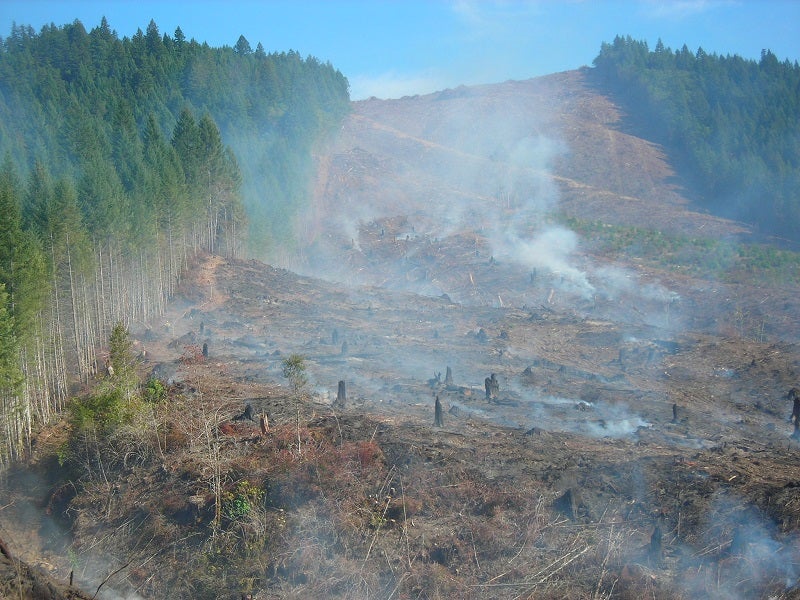Stakeholder Groups Challenge Oregon Forest Management Plan
New plan sacrifices clean water, fishing economy, carbon storage, recreational opportunities
Contact
Late yesterday, a coalition of conservation and fishing groups challenged in the U.S. District Court in Oregon a Bureau of Land Management (BLM) forest management plan, finalized Friday, that would replace the scientifically sound, ecologically credible, and legally responsible 1994 Northwest Forest Plan on millions of acres in western Oregon. The new BLM plan, collectively known as the Resource Management Plans (RMPs) for Western Oregon, eliminates protections for streamside forests, increases clearcutting, and effectively removes 2.6 million acres of federally managed public forests from the requirements of the Northwest Forest Plan.
“BLM’s new plan would impact the quality of life of rural residents, drinking water quality, wildlife habitat, and carbon storage,” said Susan Jane Brown, staff attorney with the Western Environmental Law Center. “We need to get this right. We must protect special places that Oregonians love while we work to restore forests and watersheds. A holistic view should drive our public land decisions—not simply finding ways to maximize logging.”
Where the Northwest Forest Plan provided relative stability in Oregon's often-contentious forest management, its elimination on these lands has sowed substantial discord. Last week, timber industry groups also challenged the new BLM plan in Washington, D.C. court, thousands of miles from those who will be most affected by the new plan.
The conservation and fishing stakeholders in yesterday's challenge seek to maintain the protections of the Northwest Forest Plan and its science-based requirements, asserting that BLM's new RMPs violate the Oregon and California Lands Act (O&C Act), National Environmental Policy Act (NEPA), and Administrative Procedure Act (APA), and therefore fail to support multiple uses of Oregon forests managed by the BLM.
"BLM's new plan does a disservice to the years of great progress we've made in balancing timber, recreation, and conservation forest uses," said Nick Cady of Cascadia wildlands. "We can't allow the places we love and rely on to be put at risk by a bad plan. We can do so much better than this, and we must."
The RMPs would increase logging levels by 37 percent, which could boost carbon emissions and make forests less resilient to climate change and other disturbances. In addition, the RMPs fail to recognize how healthy forests bring economic benefits to the state, such as Oregon's $12.8 billion annual outdoor recreation industry, which supports 141,000 jobs and $955 million in state and local tax revenue. Fishing organizations are highly concerned that the reduction in streamside forest protection could push imperiled species like salmon and steelhead further toward extinction. In southern Oregon, the BLM plan would remove the Applegate Adaptive Management Area that has enabled community members to play an active role in local land management decisions. The BLM plan cuts corners scientifically and legally. It would cause significant harms to the plaintiff group, including:
- Eliminating the strong water quality and habitat provisions of the Northwest Forest Plan, reducing streamside no-logging buffers by half or more (a loss of 300,000 acres of streamside reserves). These reductions threaten wild native fish, water quality, terrestrial wildlife, and aquatic recreational opportunities.
- Introducing loopholes that would increase logging in older forest, termed late-successional reserves, and eliminate survey requirements for sensitive wildlife that depend on old forest habitat to thrive. In addition, the aforementioned 300,000 acres of riparian reserves, which had been intended to grow into old forest and bolster habitat for old forest species, is now fair game for logging.
- Disempowering public input and involvement by removing BLM and the plan from collaborative Adaptive Management Area efforts.
- Enacting the least ambitious carbon sequestration alternative analyzed. Over the next century, the status quo would sequester twice as much carbon.
- Focusing on more intensive, clearcut-style logging on nearly half a million acres of forests, abandoning the direction towards restoration of forests and watersheds under the Northwest Forest Plan.
- Designating additional recreation areas, in many of which logging and off-road motorized use take precedence and could diminish the types of quiet recreation the vast majority of Oregonians enjoy.
“We have been working with BLM for the last 15 years to develop restoration strategies for degraded forest lands. This has resulted in a successful program of thinning dense young forests to improve habitat, create jobs, and produce wood,” said Doug Heiken of Oregon Wild, “Now BLM is moving in the wrong direction by reducing protection for streamside forests and adopting new loopholes that put old-growth forests at risk.”
BLM first attempted to revise its resource management plans in 2008. That plan, the result of a sweetheart settlement between the Bush Administration and the timber industry, was withdrawn by the Obama Administration in 2009, resurrected by a federal judge in 2011 in response to a timber industry lawsuit, and finally rejected by a second federal judge in 2012.

Additional Resources
About Earthjustice
Earthjustice is the premier nonprofit environmental law organization. We wield the power of law and the strength of partnership to protect people's health, to preserve magnificent places and wildlife, to advance clean energy, and to combat climate change. We are here because the earth needs a good lawyer.